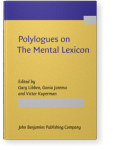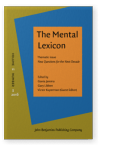Ronit Levie
List of John Benjamins publications for which Ronit Levie plays a role.
2021 Chapter 5. Hebrew adjective lexicons in developmental perspective: Subjective register and morphology Polylogues on The Mental Lexicon: An exploration of fundamental issues and directions, Libben, Gary, Gonia Jarema and Victor Kuperman (eds.), pp. 109–142 | Chapter
2019 Complexity and density of Hebrew verbs in preschool peer talk: The effect of socio-economic background What is a verb? – Linguistic, psycholinguistic and developmental perspectives on verbs in Germanic and Semitic languages, Smolka, Eva and Dorit Ravid (eds.), pp. 237–273 | Article
Hebrew verbs were analyzed in the peer talk produced by 36 Hebrew-speaking children in two age/schooling groups (4;0–5;0 and 5;0–6;0 years), and from two socio-economic backgrounds (SES), mid-high and low. Each of the four age/SES groups consisted of nine children in three triads, where each… read more
2016 Development of Hebrew derivational morphology from preschool to adolescence Acquisition and Development of Hebrew: From infancy to adolescence, Berman, Ruth A. (ed.), pp. 135–174 | Article
Three main devices construct the content-word lexicon of Hebrew: (1) nonlinear affixation of root and pattern (e.g., adjective matok ‘sweet’ from the root m-t-q and pattern CaCoC);† (2) linear concatenation of stem plus suffix (the abstract noun metik-ut ‘sweet-ness’); and (3) reduplication (the… read more
2016 Hebrew adjective lexicons in developmental perspective: Subjective register and morphology New Questions for the Next Decade, Jarema, Gonia, Gary Libben and Victor Kuperman (eds.), pp. 401–428 | Article
Objective frequency does not always provide reliable information about lexical distributions across individuals’ development. We propose the subjective ranking by experts of lexical items’ register in the sense of ‘levels of linguistic usage’, which has been independently linked to AoA, as an… read more
2016 Foundations of the early root category: Analyses of linguistic input to Hebrewspeaking children Acquisition and Development of Hebrew: From infancy to adolescence, Berman, Ruth A. (ed.), pp. 95–134 | Article
The Semitic root is commonly assumed to be the main lexical prime in Hebrew, relating morphological families in the major word classes. Psycholinguistic evidence supports the role of the consonantal root in acquisition and processing of Hebrew, from children’s early ability to extract roots from… read more
2007 12. Acquiring diminutive structures and meanings in Hebrew: An experimental study The Acquisition of Diminutives: A cross-linguistic perspective, Savickienė, Ineta and Wolfgang U. Dressler (eds.), pp. 295–317 | Chapter
The chapter describes an experimental study of the acquisition of derivational diminutives in Hebrew. The study population consisted of 48 children in four age groups: 5–6, 7–8, 10–11, 12–13, and adults. Participants were administered two tasks: an explanation task, and a production task. The… read more




